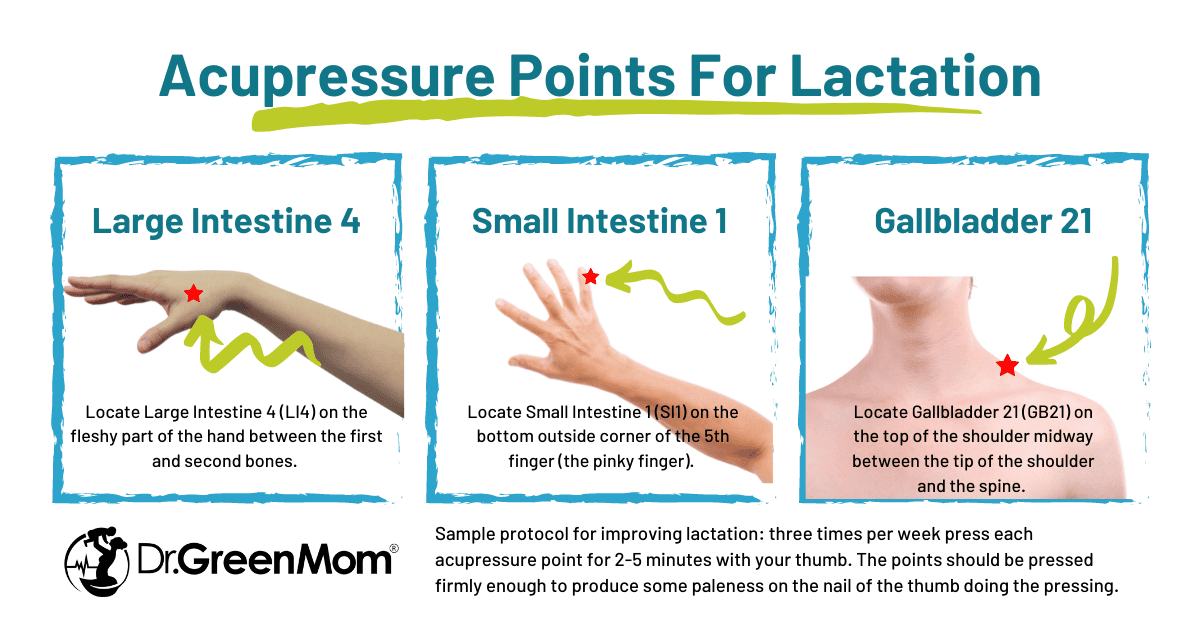Breast milk is the perfect food for babies. Alas, some moms have a hard time producing enough milk.
If you’re looking for ways to increase break milk production, this article may give you some ideas. We’re going to cover the basic breastfeeding pointers: yoga, acupressure points, herbal medicine, nutrient therapy, and pharmaceutical drug choices.
1. Make Sure Baby Has A Good Latch
Ensuring that your baby has a good latch is one of the most important keys to ensuring a good milk supply. If you’re working on your baby’s latch, this video by Dr. Jack Newman (a longtime hero of breastfeeding moms everywhere) is essential viewing. A very worthwhile 30 minutes!
2. Hydration
If you’re producing several ounces of breast milk every day, you need to replenish the fluid in your body. Many moms make it a habit to drink water while nursing so that they don’t forget. Drinking water is essential to producing an adequate milk supply. I also recommend drinking soothing herbal teas like fennel and chamomile, which taste good, provide hydration, relax the nervous system, and boost milk supply!
3. Good Nutrition
If you’re not consuming enough nutrients, your breast milk supply will suffer. Ensure that you have fat, protein, and carbohydrates at every meal and lots of colorful fruits and vegetables. If you’re having difficulty digesting food (heartburn, constipation, diarrhea, etc), that means you’re also having difficulty absorbing nutrients. Check out my article on how to heal the gut using strategies that improve digestion and absorption.
4. Regular Feeds/Pumping/Hand Expressing
Nursing regularly is important for optimal milk supply. It is also important to try to nurse at both breasts during each session.

Regular breastfeeding can be difficult if you need to be away from your baby for longer periods due to work, travel, or illness.
Breast pumps are one option for ensuring that you keep to a regular schedule of nursing. However, many moms find pumping uncomfortable, difficult, or cumbersome. Additionally, breast pumps can be expensive and aren’t accessible to everyone. If pumping isn’t for you, consider hand expressing milk. Some moms find it more comfortable and effective than pumping.
I found this video gives good instructions about how to hand express colostrum and milk: HOW TO HAND EXPRESS For A Better Breastfeeding Journey. The how-to demonstration starts at about the 6 minute mark.
5. Massage Breasts Before & During Nursing
Breast massage helps to increase circulation to the breast, increase prolactin, improve breast comfort, and prevent or treat clogged ducts and mastitis. Breast massage may also improve the quality of breast milk.
6. Skin-To-Skin Time During/After Nursing
Skin-to-skin care, aka kangaroo care, has benefits for both mom and babe. One study found that skin-to-skin time improved mother’s well-being and helped to resolve issues with latching.
7. Stress Management & Sleep
Stress management and sleep are always important to the proper function of your body and are especially critical while lactating. Unfortunately, parenting a baby or toddler can be a time of high stress and sleep deprivation. Adding stress management to the to-do list often increases stress rather than decreasing it. What I’ve found works better for myself and my patients is to focus on self-compassion, let go of idealized versions of motherhood, and find time for self-care.
8. Yoga For Increased Milk Supply
Yoga can increase breast milk volume through several different mechanisms: 1) exercising muscles around the breast improves circulation, 2) mindful movement strengthens the mind-body connection and improves well-being, and 3) breath work and meditation improve mental health and promote stress reduction.
One study found that daily yoga practice for six days improved milk volume by an average of 110 ml (just under half a cup) at each feeding. Unfortunately, this study didn’t report which poses were used or how long yoga was practiced. However, I believe that any practice that fits your lifestyle and creates feelings of relaxation and peace would be helpful.
Video: 15 Minute Postnatal Yoga For Breastfeeding | Postpartum Yoga To Relieve Back Pain
9. Acupressure For Increased Milk Supply
Acupressure has also been found to increase milk supply. In one study, acupressure performed three times per week on the three points shown below was reported to have increased the volume of breast milk produced significantly.
Mothers were instructed to press each acupressure point for 2-5 minutes on both sides of the body three times per week with their thumbs. The points should be pressed firmly enough to produce some paleness on the nail of the thumb doing the pressing.
Small Intestine 1 (SI1) is located at the inner corner of the pinky fingernail and benefits the breasts and lactation. Gallbladder 21 (GB21) is located on the top of the shoulder, midway between the spine and the tip of the shoulder. GB21 is helpful when milk isn’t flowing. Large Intestine 4 (LI4) is located midway between the first and second bones of the hand and moves qi. LI4 helps to make the other two points more effective.

10. Herbal Medicine For Increased Milk Supply
Herbal medicine has been used to improve milk supply since time immemorial.
Herbal teas are commonly chosen by breastfeeding mothers because they are a good way to get both the herb and hydration. Tinctures and glycerites are able to provide more concentrated doses of herbs, but breastfeeding mothers may find that their babies are sensitive to the alcohol content of the tinctures. In most cases, a glycerite is a better choice than an alcohol-based tincture. Dried, encapsulated herbs are the most practical way to get the highest doses of lactation-boosting herbs, some of which may be strong tasting. Lactation cookies take advantage of the lactation promoting action of oats and combine them with other herbs for a fun and easy way to improve milk supply.
Herbs that may be used to boost milk supply include fennel, goat’s rue, red raspberry leaf, borage, chaste tree berry, ginger, stinging nettles, moringa, shatavari, milky oats, chamomile, dandelion root, blessed thistle, fenugreek, vervain, hops, and milk thistle.
11. Nutrient Therapy For Increased Milk Supply
A healthy diet is the foundation for good health and good milk supply. However, sometimes diet alone doesn’t provide enough nutrients for optimal health. I recommend taking a quality prenatal vitamin to provide optimal nutrients for pregnancy and breastfeeding. A high-quality omega-3 supplement is also necessary to provide the DHA needed for the incredible amount of brain growth that happens in the first months and years of life.
Nutrients that seem especially important for lactation include DHA, vitamin D, vitamin A, vitamin E, vitamin K, zinc, copper, iron, calcium, iodine, choline, vitamin B12, folate, and protein.
12. Conventional Medicine For Increased Milk Supply
Some conventional medicines are available for increasing milk supply if other options fail. Galactagogue drugs include domperidone, metoclopramide, sulpiride, and thyrotropin-releasing hormone. There are risks and benefits to each, which should be discussed with a doctor.
Summary
Breastfeeding is a personal and unique journey for each mom and baby. If you’re struggling to produce enough breast milk there are many natural and conventional options to increase your supply. The most important thing is to find strategies that work for your life, goals, and values.
On a personal note: I know that breastfeeding can be a difficult and complex topic for many moms. I support all moms, including moms who aren’t able to breastfeed and moms who choose not to.
References:
Benefits of Yoga in Increasing Lactating Mother’s Breast Milk Production
Why Self-Compassion Is So Important for New Mothers | Psychology Today Canada
Esfahani MS, Berenji-Sooghe S, Valiani M, Ehsanpour S. Effect of acupressure on milk volume of breastfeeding mothers referring to selected health care centers in Tehran. Iran J Nurs Midwifery Res. 2015 Jan-Feb;20(1):7-11. PMID: 25709684; PMCID: PMC4325417.
Cortés-Albornoz, M. C., García-Guáqueta, D. P., Velez-van-Meerbeke, A., & Talero-Gutiérrez, C. (2021). Maternal Nutrition and Neurodevelopment: A Scoping Review. Nutrients, 13(10), 3530. https://doi.org/10.3390/nu13103530
Lewis ED, Richard C, Goruk S, Wadge E, Curtis JM, Jacobs RL, Field CJ. Feeding a Mixture of Choline Forms during Lactation Improves Offspring Growth and Maternal Lymphocyte Response to Ex Vivo Immune Challenges. Nutrients. 2017 Jul 7;9(7):713. doi: 10.3390/nu9070713. PMID: 28686201; PMCID: PMC5537828.
Wagner, C. L., Hulsey, T. C., Ebeling, M., Shary, J. R., Asghari, G., Howard, C. R., Baatz, J. E., Newton, D. A., Wahlquist, A. E., Reed, S. G., Taylor, S. N., Lawrence, R. A., & Hollis, B. W. (2020). Safety Aspects of a Randomized Clinical Trial of Maternal and Infant Vitamin D Supplementation by Feeding Type Through 7 Months Postpartum. Breastfeeding medicine : the official journal of the Academy of Breastfeeding Medicine, 15(12), 765–775. https://doi.org/10.1089/bfm.2020.0056
Korsmo, H. W., Jiang, X., & Caudill, M. A. (2019). Choline: Exploring the Growing Science on Its Benefits for Moms and Babies. Nutrients, 11(8), 1823. https://doi.org/10.3390/nu11081823
Foong, S. C., Tan, M. L., Foong, W. C., Marasco, L. A., Ho, J. J., & Ong, J. H. (2020). Oral galactagogues (natural therapies or drugs) for increasing breast milk production in mothers of non-hospitalised term infants. The Cochrane database of systematic reviews, 5(5), CD011505. https://doi.org/10.1002/14651858.CD011505.pub2
Geddes, D. T., Gridneva, Z., Perrella, S. L., Mitoulas, L. R., Kent, J. C., Stinson, L. F., Lai, C. T., Sakalidis, V., Twigger, A. J., & Hartmann, P. E. (2021). 25 Years of Research in Human Lactation: From Discovery to Translation. Nutrients, 13(9), 3071. https://doi.org/10.3390/nu13093071
Foda, Mervat I.*; Kawashima, Takaaki†; Nakamura, Sadako†; Kobayashi, Michiko‡; Oku, Tsuneyuki† Composition of Milk Obtained From Unmassaged Versus Massaged Breasts of Lactating Mothers, Journal of Pediatric Gastroenterology and Nutrition: May 2004 – Volume 38 – Issue 5 – p 484-487







